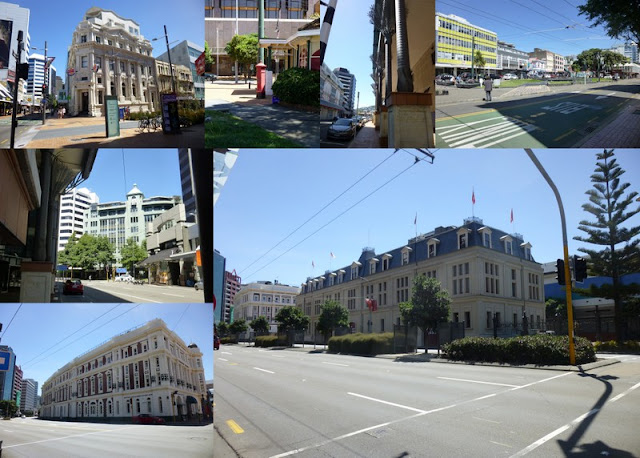January 27, 2013 in port Wellington, New Zealand – Welcome to Hobbit Land
Silver Shadow docked at Aotea Quay, Port Nicholson
(Wellington’s harbor) at 8:00am and caught the 10am shuttle into Brandon Street
and Lambton Quay in the Wellington downtown.
Our plan was to visit recently-completed Te Papa Tongarewa – Museum of
New Zealand which was in walking distance along the Wellington waterfront.
Wellington, New
Zealand and Aotea Quay from Port Nicholson Harbor
Horror of horrors! Another
cruise ship in port!
The sun was
shining and making it a wonderful Sunday for an outing. Large numbers of people were strolling along the waterfront, or
participating in numerous tourist activities – jet skis, sailing, and high
diving. (New Zealanders are an
adventuresome lot, with a taste for things like bungee jumping and other
suicide-oriented endeavors.) The
waterfront area is under redevelopment, with old go-downs being converted to
other uses – art centers. Some older
buildings have been torn down, but buildings of historical, architectural
and/or cultural significance are being rehabilitated or maintained. Wellington has been the capital of New
Zealand since 1895. The lynch pin of
this revitalization is the Te Papa Tongarewa – Museum of New Zealand, whose
collections are housed in a recently-completed, extremely impressive, modern
building
.
Converted and
Restored Buildings
Buildings of these types make the waterfront area very
attractive.
Entrance to Te Papa
Tongarewa – Museum of New Zealand
New Zealand’s equivalent of the Smithsonian Institution.
On entering
the Te Papa, the local vernacular for the museum, you are greeted by a
volunteer. The volunteer immediately
explains that the museum is free of charge, except for traveling special
exhibits. And, that its four-plus floors
of exhibits contain natural history, ethnography, historical, and fine art collections. Needless to say, the museum is huge and
cannot be viewed in a single visit. It
houses probably the finest collection of materials on Maori ethnography in the
world. The whole thing is overwhelming,
and you must pick a specific collection or part of a collection for
viewing. To consider the alternatives,
we went immediately to the coffee shop for a cappuccino.
On the way,
we passed a relic of Capt. Cook’s explorations of New Zealand and the Pacific: A cannon, from the HMS Endeavor, which had to
be thrown overboard off New Zealand to free Endeavor from grounding on a reef. A Capt. Cook Society member, J was fascinated
and took MANY pictures of the salvaged cannon.
HMS Endeavor’s Cannon
Maybe five images are a little excessive.
After much
debate, we chose to spend most of our time in the museum’s exhibits on
immigration to New Zealand. They traced
the history of New Zealand’s European and Asian immigrant population through
their artifacts and handicrafts. The
exhibits were extremely well done and illustrated the country’s history from
the early 19th until the late 20th century.
Te Papa’s Artifacts
of History
Maori war canoes, Endeavor’s anchor, and an early air craft
– the stuff of history.
After looking
at the exhibits for about two hours, we were saturated and could absorb no more. Stopping in the museum shop on the way out, J
found a t-shirt with a New Zealand Stamp on it and immediately purchased it for
an exorbitant amount. Just what he needs
-- another overpriced t-shirt. He
justified it as financially “helping” the museum. Rationalization is wonderful.
Leaving the
museum, we walked back through Wellington’s downtown to reach the shuttle bus
stop. Wellington is another city, like
Auckland, with a great diversity of architecture, and we enjoyed seeing the
city on-foot. It took us about two hours
to get back to the shuttle bus stop, and we were beginning to feel we might
have enjoyed the walking a bit too much.
Wellington’s Varied
Architecture
It is good to take building photos from the street when
there is no traffic.
We caught an
early afternoon shuttle back to the ship in time for a late lunch. The rest of the day was spent recovering for our
extensive walking tour of Wellington. At
5:30pm, just after that important event, “Team Trivia,” we sailed for Akaro, our
first port on the South Island of New Zealand.
Port Nicholson (Maori
-- Great Harbor of Tara) from Seaward
Goodbye, Wellington; we’re headed for the South Island.







No comments:
Post a Comment